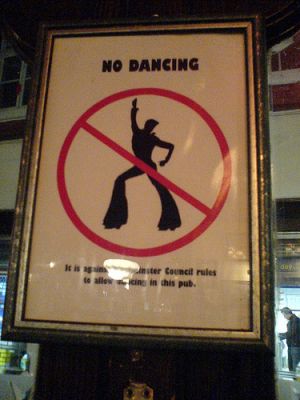The Safety Dance
 So if it's Monday, that must mean I write about something from The New York Times Sunday Magazine. And so I will. Mark Oppenheimer used the hook of a nondenominational university in Arkansas permitting dance for the first time as a way to explore some Christians' view of dancing. The piece is ridiculously smooth and well-written and looks at the issue from a number of angles. Mark Oppenheimer edits In Character, a thrice-yearly journal that looks at a single ethical concern each issue. He has written for The Believer (not a religious publication but a pretty awesome one), The New Yorker, Harper's, Slate, The Wall Street Journal and The Christian Century. He's not ideological per se but he clearly has a healthy respect for religion and ethics. And The New York Times Sunday Magazine found him although he's never written for Mother Jones.
So if it's Monday, that must mean I write about something from The New York Times Sunday Magazine. And so I will. Mark Oppenheimer used the hook of a nondenominational university in Arkansas permitting dance for the first time as a way to explore some Christians' view of dancing. The piece is ridiculously smooth and well-written and looks at the issue from a number of angles. Mark Oppenheimer edits In Character, a thrice-yearly journal that looks at a single ethical concern each issue. He has written for The Believer (not a religious publication but a pretty awesome one), The New Yorker, Harper's, Slate, The Wall Street Journal and The Christian Century. He's not ideological per se but he clearly has a healthy respect for religion and ethics. And The New York Times Sunday Magazine found him although he's never written for Mother Jones.
He has a Ph.D. in religious history from Yale and his two books are Thirteen and a Day: The Bar and Bat Mitzvah Across America and Knocking on Heaven's Door: American Religion in the Age of Counterculture. Here's how he begins:
On the first night of December, an unseasonably cold one in the Ozarks, the boys and girls of John Brown University primped in their zoot suits, suspenders, waistcoats, spats, faux-hawks, pompadours, knee-length pleated skirts, nylons, snoods and inch-high black heels and marched through snow drifts to their gymnasium in the Walton Lifetime Health Complex, one of northwest Arkansas's monuments to the Wal-Mart family's generosity. Inside, the gymnasium was decorated with rows of Christmas lights strung overhead across the width of the basketball court, from one railing of the mezzanine jogging track to the other. The occasion, which would last from 8 p.m. to 11 p.m., was a dance, the first of its kind at this small, nondenominational Christian college.
He contends, with the help of various evangelical scholars, that schools that formerly banned dancing are more accepting of the practice as foreign enrollment increases. He explains how some fundamentalists and other Christians came to ban drinking, smoking and dancing. But he also shows how dancing is lauded by some of the same type of Christians:
For conservative Christians, dancing is also a way to teach the virtues. Students are schooled in chivalry, taught always to walk a lady to and from the floor, applaud the band and ask the girl standing by herself for a dance. A swing, ballroom or square dance usually takes place in a well-lighted space. The swing dancers of yore may have been escaping supervision, but now dancing is a family affair: Nathan [Cozart] and Craig [Congdon] both dance with their siblings. (Craig danced with his mom.) Unlike Christian rock, the music for these dances is palatable to older generations too. Formal dances require instruction in the proper steps, which creates a role for parents or teachers. And of course, the sexuality of dance can be a positive thing, if it provides a sexual release without the sex.
It's obvious that Oppenheimer took the time to get to know his subjects. He understands their diversity, their unique viewpoints and their biblical approach. In fact, the reader ends up pulling for various dancers in the school's dance contest because they're made so human. This is a minor quibble, but since I do street dance, I have to complain. Oppenheimer writes:
Still it's hard to imagine that hip-hop dancing would ever be acceptable at J.B.U. -- if too sexual, it wouldn't be Christian, and if too Christian, it would be laughable.
This could only be written by someone who doesn't understand hip-hop dance. There is nothing that makes hip-hop a more sexual category of dance than any other. But this is GetReligion, not GetDance, so I'll stop.
Anyway, let me know what you thought of the article. It certainly didn't paint these people in a glowing light, although it was sympathetic. I'd be curious how some of you Shaw Moore (John Lithgow in Footloose) types feel about the portrayal.
Photo via iambrain.dk on Flickr.